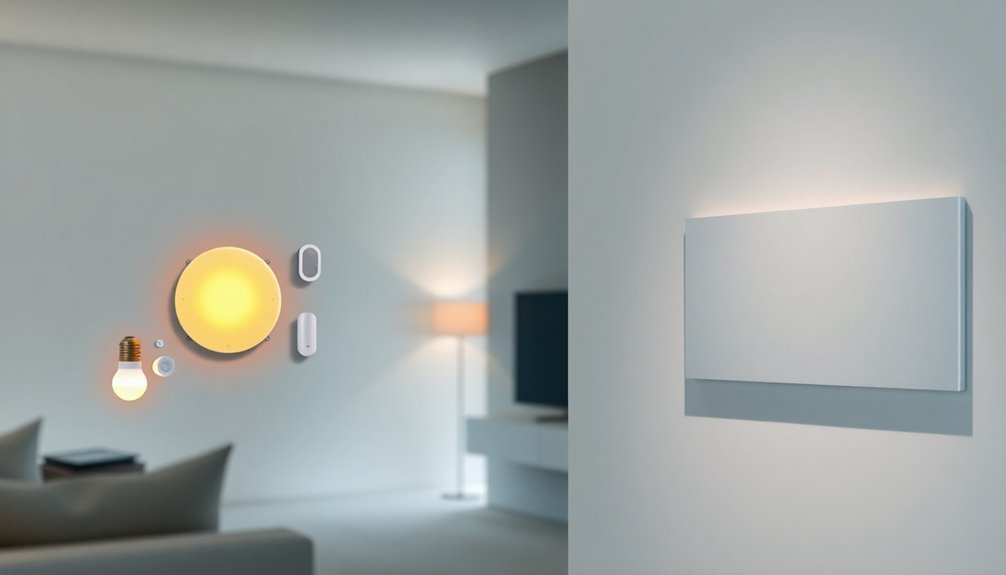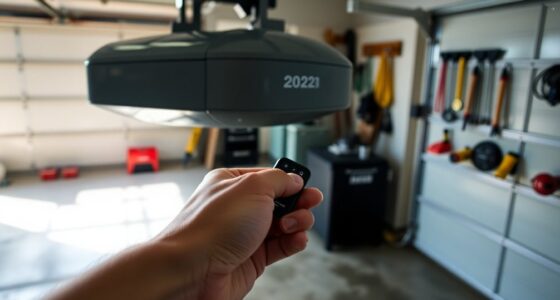Zigbee and KNX are both smart home technologies but cater to different needs. Zigbee is a wireless protocol ideal for DIY enthusiasts, offering easy installation and flexibility for smaller projects. It's budget-friendly with devices often under $500. On the other hand, KNX is a wired system suited for large-scale applications, providing high reliability and advanced security, but at a higher upfront cost. KNX requires professional installation and has a steep learning curve. Choosing between them depends on your project size and goals, so stick around to explore which option might be the perfect fit for you.
Key Takeaways
- Zigbee is a wireless protocol ideal for smart homes, while KNX is a wired standard primarily used in commercial and industrial automation.
- Zigbee offers easy installation and lower initial costs, making it suitable for DIY projects, unlike KNX's complex setup requiring professional installation.
- KNX provides higher reliability and scalability, ideal for larger applications, whereas Zigbee is better for smaller, budget-friendly smart home solutions.
- Zigbee utilizes mesh networking for extended coverage with low power consumption, while KNX ensures enhanced security through its wired connections.
- Long-term value and reliability make KNX appealing for large installations, whereas Zigbee excels in flexibility and ease of integration for smaller projects.
Overview of Zigbee
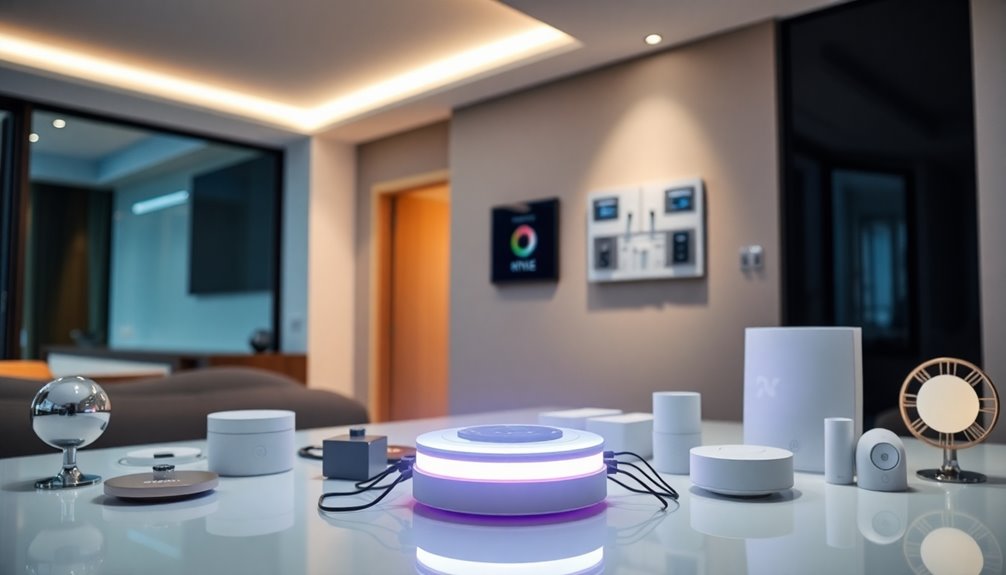
Zigbee is a powerful wireless communication protocol designed specifically for smart home devices, like lights and thermostats. It excels in low-power, low-data-rate applications, making it perfect for battery-operated devices.
Operating mainly in the 2.4 GHz frequency band, Zigbee utilizes mesh networking technology, allowing your devices to communicate over longer distances. This means signals can be relayed through multiple interconnected devices, enhancing coverage throughout your home.
One of Zigbee's standout features is its flexibility; you can easily add or remove devices without disrupting your network. Typically, you'll need a central hub for managing your Zigbee devices, ensuring seamless integration and communication between various products from different manufacturers.
Enjoy a smart home experience with Zigbee's efficiency and reliability!
Overview of KNX
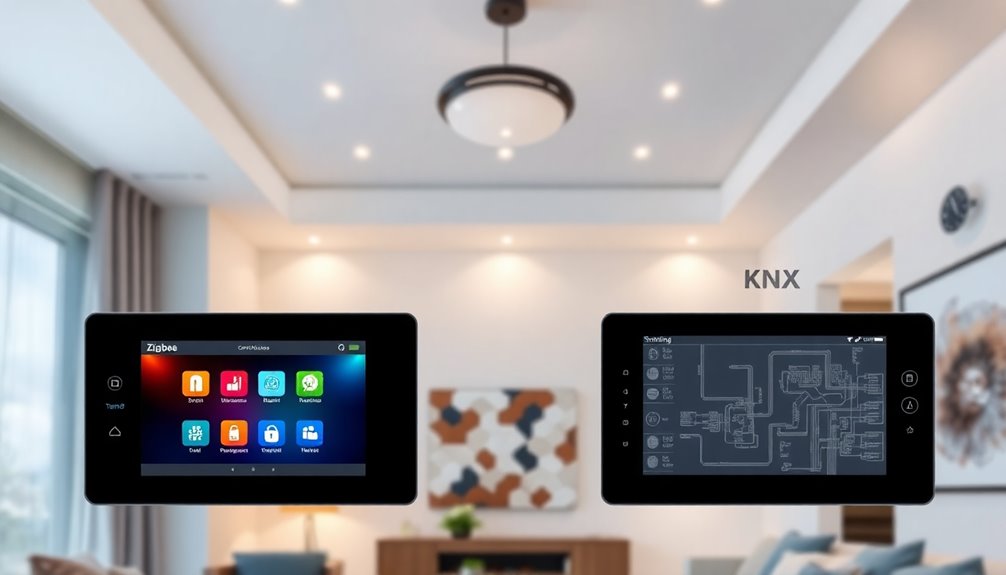
When it comes to building automation, KNX stands out as a globally recognized wired communication standard.
You'll find it primarily used in commercial and industrial settings, offering reliable control over systems like lighting, heating, ventilation, and security.
KNX supports a large number of devices on a single network, making it perfect for complex environments where multiple automation needs arise.
Its compatibility with various other protocols, including BACnet, Modbus, and EnOcean, guarantees extensive integration possibilities.
Plus, the wired architecture of KNX enhances security and privacy, greatly reducing the risk of unauthorized access that often plagues wireless systems.
With KNX, you can achieve a robust and efficient automation system tailored to your specific requirements.
Key Advantages of Zigbee
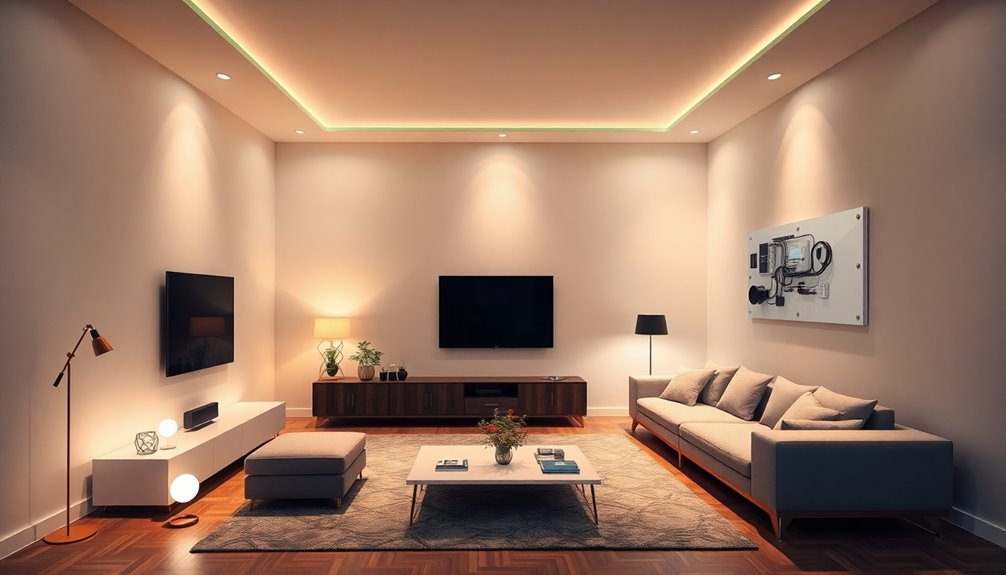
Zigbee offers you wireless convenience, making it easy to control your smart home without dealing with messy wires.
It's also a cost-effective solution, allowing you to automate your space without breaking the bank.
Plus, the easy installation process means you won't need any specialized tools to get started.
Wireless Convenience
By eliminating the need for complex wiring, Zigbee makes it easy to upgrade your home with smart technology without major renovations.
Its wireless convenience allows you to retrofit existing homes seamlessly, enhancing your automation experience.
With plug-and-play capabilities, you can easily add or remove devices from the network without disrupting the entire system, giving you the flexibility you need.
Zigbee devices also boast low power consumption, which means longer battery life for sensors and remote controls, perfect for battery-operated applications.
Plus, the mesh networking feature enables devices to communicate over longer distances by relaying signals, ensuring broad coverage throughout your home.
Embrace Zigbee for a hassle-free and efficient smart home setup.
Cost-Effective Solution
With smart home technology becoming increasingly popular, many homeowners are looking for a cost-effective solution that doesn't compromise on quality.
Zigbee stands out as an ideal choice for smart home automation, offering lower initial costs compared to KNX. Its plug-and-play capabilities allow you to easily add or remove devices, saving you money on professional installation.
Plus, Zigbee's low power consumption extends battery life, reducing maintenance costs over time. The absence of complex wiring cuts down on installation time and labor expenses, making it even more budget-friendly.
With compatibility across a wide range of devices, Zigbee enables you to create a versatile and affordable smart home ecosystem without being tied to any specific manufacturer. Furthermore, its ability to facilitate budget management makes it easier for homeowners to stay within their financial means while enhancing their living spaces.
Easy Installation Process
While many smart home technologies can be challenging to install, Zigbee simplifies the process, making it accessible for everyone.
Its easy installation process is DIY-friendly, allowing you to set up devices without needing professional help or complex wiring. With plug-and-play capability, you can easily add or remove devices without disrupting your existing network.
Most Zigbee devices require minimal configuration, often pairing simply through a mobile app or hub interface. The wireless nature of Zigbee cuts down on installation time and costs since you won't need extensive cabling or construction work.
Plus, its mesh network architecture guarantees that devices communicate effectively, even in tricky layouts, enhancing your overall experience. Zigbee truly makes smart home integration a breeze!
Key Advantages of KNX
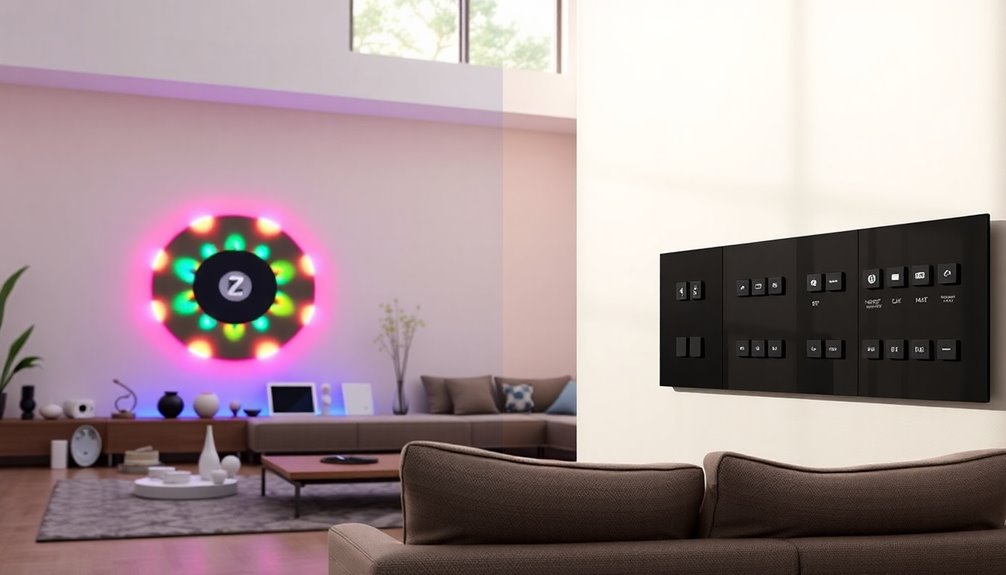
KNX stands out as a premier choice for building automation because it combines reliability, scalability, and flexibility. KNX systems are perfect for complex environments due to their ability to support numerous devices on a single network. This makes them ideal for extensive commercial applications. You'll appreciate the energy efficiency that comes from centralized control, enabling sophisticated automation of lighting, heating, and ventilation. Additionally, the wired infrastructure enhances security by minimizing unauthorized access risks. With compatibility across various manufacturers, you can easily integrate diverse automation solutions within your KNX network.
| Advantage | Description | Benefit |
|---|---|---|
| Reliability | High dependability in communication | Reduced system failures |
| Scalability | Supports many devices on a single network | Ideal for large applications |
| Energy Efficiency | Centralized control for automation | Lower energy costs |
| Security | Wired connections enhance safety | Decreased risk of unauthorized access |
Installation Considerations
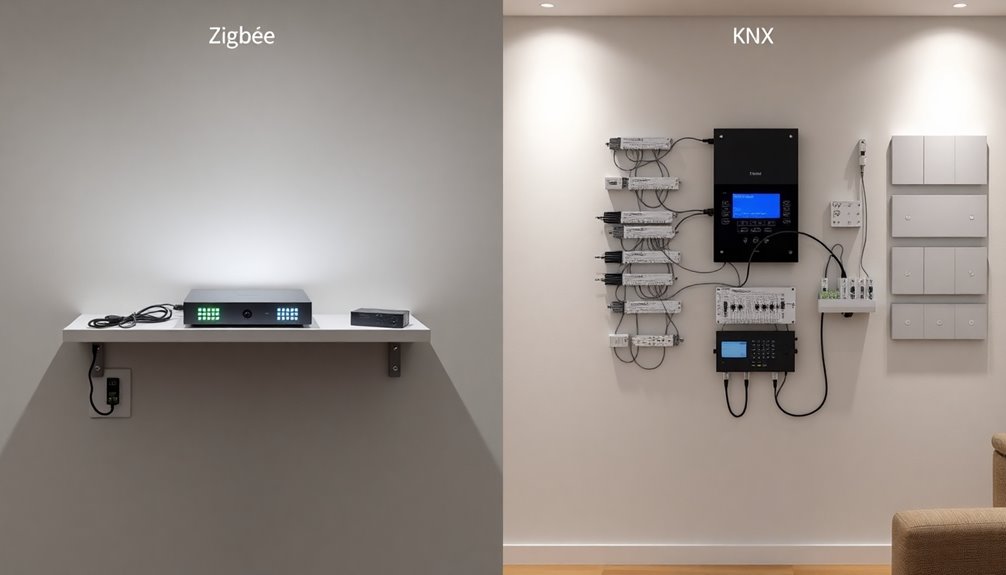
When considering installation, it's essential to recognize that KNX requires professional expertise due to its wired architecture and complex setup. This often leads to higher upfront labor costs compared to Zigbee, which offers a DIY-friendly approach.
Zigbee's wireless nature allows for straightforward installation without extensive cabling, making it ideal for retrofitting existing homes. If you're dealing with structures that can't accommodate new wiring, Zigbee is the clear winner.
Additionally, configuring KNX usually involves advanced programming using proprietary software, while Zigbee typically allows for simpler, user-friendly device pairing.
Long-term, KNX demands more planning for future upgrades, whereas Zigbee supports easier, incremental changes as your needs evolve.
Choose wisely based on your installation capabilities and future plans!
Use Cases for Zigbee

Zigbee shines in residential settings, making it easy for you to control smart devices like lights and thermostats.
Its flexible integration means you can mix and match devices from different manufacturers without hassle.
Plus, you won't have to worry about extensive installations, so setting up your smart home can be a breeze.
Ideal for Residential Settings
As homeowners seek to simplify their lives with technology, Zigbee stands out as an ideal solution for residential settings. Its wireless convenience allows you to install devices easily without extensive wiring, making it perfect for smart homes.
Zigbee's low power consumption guarantees your battery-operated devices last longer, reducing the hassle of frequent replacements. With its mesh networking capability, you'll enjoy seamless connectivity across various devices throughout your home, even over longer distances.
Plus, Zigbee is budget-friendly, offering an accessible way to implement home automation solutions without breaking the bank. Supporting a wide range of compatible smart home devices, it enables you to integrate diverse products into your automation ecosystem effortlessly.
Embrace the future of living with Zigbee.
Flexible Smart Device Integration
While integrating smart devices into your home, you'll appreciate how easily Zigbee allows for flexible connections. Its plug-and-play capabilities let you add or remove devices without disrupting your setup, making it perfect for your evolving smart home.
With low power consumption, battery-operated devices like sensors can last longer, reducing maintenance needs. Zigbee's mesh networking enhances coverage, enabling devices to communicate over longer distances—ideal for larger homes.
Plus, the variety of compatible devices, from smart bulbs to security cameras, guarantees you can customize your ecosystem. Installation is simple, empowering DIY enthusiasts to create tailored automation scenarios without needing extensive technical skills.
Zigbee truly excels in flexible smart device integration, making your smart home experience seamless and enjoyable. Additionally, its ability to support high refresh rates ensures that even your gaming devices can be integrated smoothly into your home setup.
Use Cases for KNX
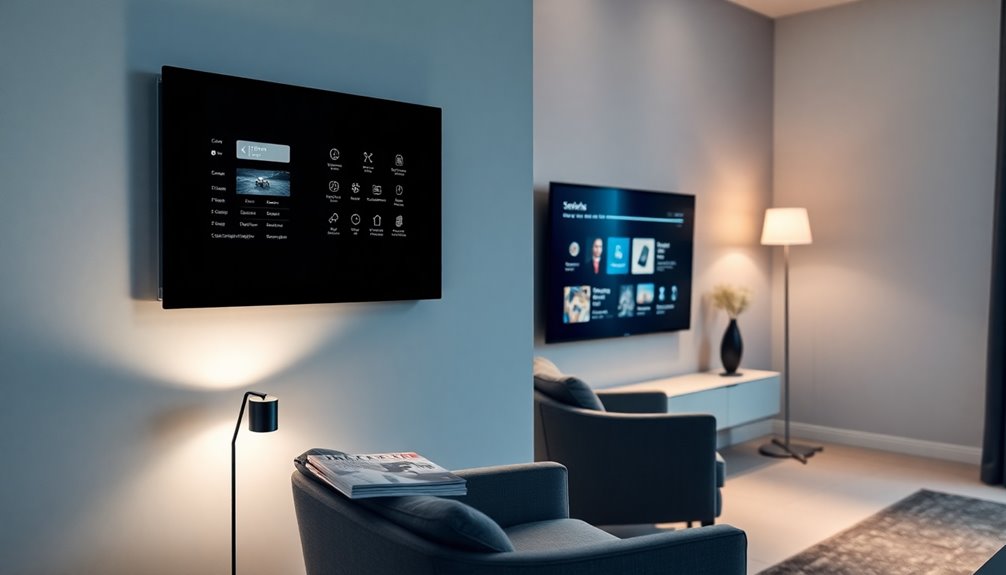
KNX technology shines in various settings, particularly where reliability and efficiency are paramount. In large commercial buildings, you can count on KNX for dependable control of lighting, heating, and ventilation systems, enhancing operational efficiency and energy management.
When it comes to residential applications, especially in new constructions, KNX allows for seamless automation of dimming, climate control, and security functions without the constraints of wireless signals.
Compared to Zigbee, KNX supports a broader range of devices from multiple manufacturers, giving you customized solutions for complex environments.
Plus, with its wired nature, you don't have to worry about performance issues in concrete structures. Even during network failures, basic operations remain functional, ensuring your critical systems stay operational.
Cost Analysis of Both Systems
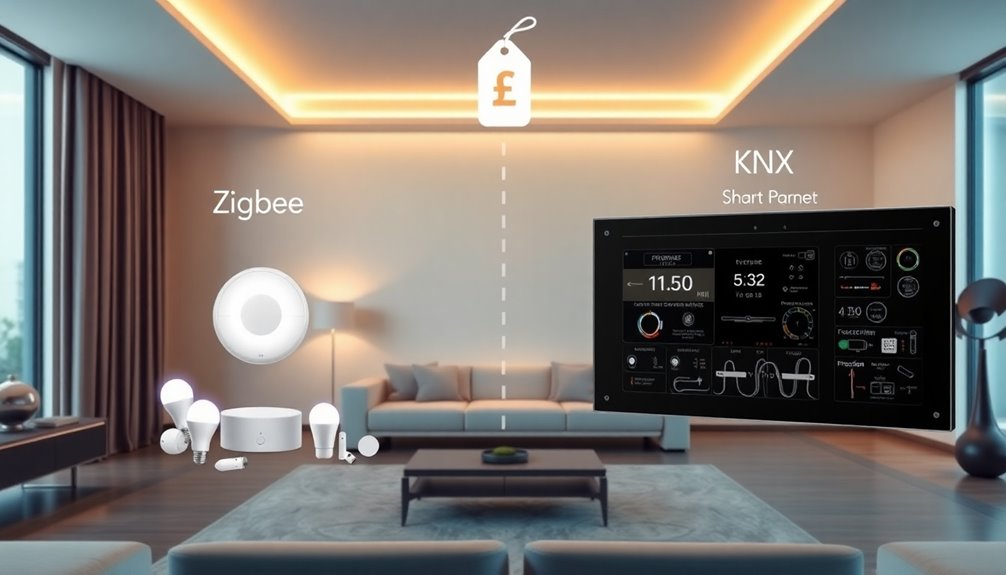
When comparing the costs of KNX and Zigbee systems, you'll notice a significant difference in initial investments.
While KNX may seem pricey upfront due to installation and wiring, it could offer better long-term value.
On the other hand, Zigbee's budget-friendly options make it attractive for smaller projects, but consider the potential maintenance costs as you evaluate your choices.
Initial Investment Comparison
Investing in smart home technology can vary greatly depending on the system you choose. If you opt for a KNX system, be prepared for a higher initial investment. The costs can range from several hundred to several thousand dollars due to professional installation and extensive wiring.
On the other hand, Zigbee devices usually come with lower upfront costs, often allowing you to set up a basic configuration for under $500. This makes Zigbee a more accessible option for budget-sensitive consumers and DIY enthusiasts.
While KNX offers a robust solution for larger installations, Zigbee provides a cost-effective entry point, making your initial investment more manageable without sacrificing functionality for smaller setups. Additionally, considering the diversification of investments can help you optimize your overall budget for smart home technology.
Long-Term Maintenance Costs
Long-term maintenance costs can greatly influence your choice between smart home systems.
KNX systems often come with higher maintenance expenses due to their complexity, requiring professional servicing and specialized knowledge for updates and reconfigurations.
In contrast, Zigbee's user-friendly design allows you to troubleshoot and replace devices easily, leading to lower long-term maintenance costs.
However, while Zigbee devices are generally more affordable upfront, they may need frequent replacements due to their consumer-grade nature.
On the flip side, KNX devices usually last longer, potentially resulting in fewer replacements over time.
Value Proposition Assessment
Evaluating the value proposition of smart home systems boils down to a careful cost analysis of both KNX and Zigbee.
KNX systems often require a higher initial investment due to professional installation and extensive wiring, making them less accessible for entry-level users. However, their reliability and longevity can justify this expense in the long run.
Zigbee, on the other hand, offers a lower upfront cost and simpler installation, ideal for budget-sensitive consumers. While maintenance costs for KNX may be higher, Zigbee typically incurs lower upkeep expenses.
Fundamentally, KNX excels in larger, commercial environments, while Zigbee caters to residential applications where ease of use and affordability are prioritized, each presenting distinct value propositions for different needs.
Performance Metrics Comparison
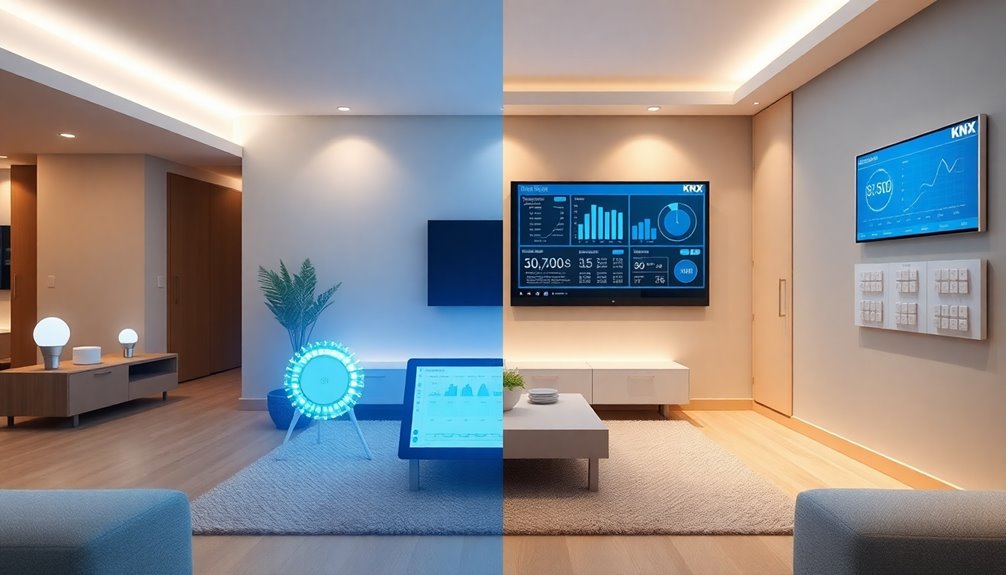
When choosing a smart home system, understanding the performance metrics is essential to guarantee you get the best fit for your needs. Zigbee and KNX both offer unique advantages in automation systems, but they differ in key aspects:
| Metric | Zigbee | KNX |
|---|---|---|
| Range | 100-300 ft (mesh network) | Wired connections |
| Data Rate | ~250 Kbps | Slower than Wi-Fi |
| Latency | Instant communication | Reliable performance |
| Power Consumption | Extremely low | Moderate (wired/wireless) |
Zigbee excels in low-power applications with quick response times, while KNX effectively supports larger installations. Consider these metrics to select the smart solution that aligns with your home's needs.
Final Thoughts on Selection

Choosing the right smart home system ultimately hinges on your specific needs and preferences.
If you're managing a large-scale commercial project, KNX might be your best bet due to its high reliability and scalability, allowing for extensive integration over time.
However, if you're setting up a cozy smart home, Zigbee offers flexibility and easier DIY installation, making it accessible for budget-conscious users.
Consider your long-term goals: KNX may involve higher upfront costs but can lower maintenance expenses in the long run.
On the other hand, Zigbee's low initial costs come with potential device replacement challenges.
Ultimately, weigh your priorities in reliability, ease of use, and scalability to make a well-informed decision that suits your lifestyle.
Frequently Asked Questions
What Is the Difference Between Zigbee and KNX?
When you're exploring smart home technologies, you'll notice that Zigbee and KNX serve different needs.
Zigbee's your go-to for low-power, DIY-friendly setups, making it easy to add devices.
On the other hand, KNX is suited for larger installations, requiring professional wiring and offering robust connectivity.
If you want flexibility and lower costs, Zigbee's ideal.
But, if you're looking for extensive automation and reliability, KNX might be more your speed.
What Is the Disadvantage of Zigbee?
Zigbee has its disadvantages, especially in environments with many devices, where you might experience connectivity issues due to network congestion.
You'll also find that battery-operated devices can require frequent replacements, adding to your maintenance efforts.
Additionally, if you have a larger home, you may need signal repeaters or hubs to guarantee coverage.
Finally, Zigbee's interoperability is limited to devices that follow its specific protocol, which can restrict your options.
Is KNX Worth It?
When you're weighing options for your smart home, consider reliability, complexity, and future needs.
If you're seeking a robust system that minimizes interference and enhances security, KNX could be worth it. You'll enjoy extensive compatibility and advanced features, perfect for larger setups.
While it may require a higher initial investment, the long-term benefits like fewer upgrades and professional support might make it a smart choice for your home automation journey.
Is Zigbee Good for Smart Homes?
Yes, Zigbee's a great choice for smart homes! It offers easy installation and configuration, perfect for retrofitting without extensive wiring.
With low power consumption, your battery-operated devices can run for years, saving you hassle and money. The mesh networking feature enhances connectivity, ensuring reliable communication between devices.
Plus, Zigbee's cost-effective, making it ideal if you're budget-conscious. You'll enjoy seamless integration of various smart devices, creating a cohesive and efficient automation setup!
Conclusion
In the epic battle of smart home tech, choosing between Zigbee and KNX is like picking your favorite superhero—each has its incredible powers! If you crave flexibility and ease, Zigbee's your go-to sidekick. But if you're after a robust, bulletproof system for extensive automation, KNX is your ultimate champion. So, weigh your needs carefully because the right choice can transform your home into a futuristic paradise or leave you lost in a tech jungle! Choose wisely!
